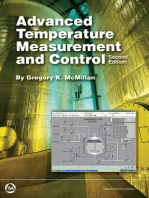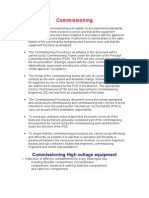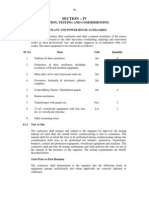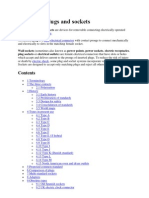Testing & Commissioning
Testing & Commissioning
Uploaded by
praveshkafleCopyright:
Available Formats
Testing & Commissioning
Testing & Commissioning
Uploaded by
praveshkafleOriginal Description:
Copyright
Available Formats
Share this document
Did you find this document useful?
Is this content inappropriate?
Copyright:
Available Formats
Testing & Commissioning
Testing & Commissioning
Uploaded by
praveshkafleCopyright:
Available Formats
START UP & COMMISSIONING OF HP
1.1 Planning
For small hydro plants, the specifications should stipulate that the lead equipment supplier (usually
turbine supplier) is responsible for startup & commissioning activities and as such should furnish a
comprehensive and coordinated schedule of start up and commissioning which chronologically
details field activities. Time duration after completion of field tests of various electrical and
mechanical systems should not exceed 10 to 15 days for small hydro installation. A well planned
schedule will make it possible to carry out certain tests in parallel to minimize the time duration for
start up and commissioning.
1.2 Start Up & Commissioning Activities
The process of start-up and commissioning of hydro electric plant has following stages:
Field Tests
Start up Tests
- Dry condition tests (Prestart up, pre-commissioning tests)
- Watered up condition tests
Commissioning Tests
Testing of Control System
Commercial Operation
Technical Review of Commissioning of a Small Hydropower Station
1.2.1 Field Tests
At this stage all systems and subsystems are individually tested
Test at this stage include following:
- All critical unit clearances and dimensions are checked
- Alignment of unit shaft system
- Calibration and adjustment of all temperature sensing devices, pressure switches, flow switches,
transducers is done
- Continuity of all cabling and their connection as per cable schedules are checked
- Operation of all control system in both energized and de-energized state is checked
- Hydrostatic tests of all pressurized fluid system
- AC/DC high potential tests
- Bench test of protective relaying
- Check out also include all field testing that can be performed before the turbine begins to operate
All tests carried out must be properly documented for each system and subsystem and signed by tests
engineers of manufactures and plant owner. This documentation helps the owner to identify potential
problem in specific equipment before start-up and take remedial measure in advance.
1.2.2 Start-up Tests
Before starting of machine, start up tests of generating units, all other systems and subsystems should
have been done during field tests. These tests are divided in two categories.
Pre-commissioning tests (Dry Condition)
Commissioning tests (Watered up condition)
(a) No load tests
(b) Load tests or performance tests
1.2.3 Pre-commissioning Tests
These tests are conducted before charging the water conductor system of the unit. These checks can
be carried out in parallel with field testing. Some typical tests are as follows:
Hydrostatic tests of generator coolers, bearing coolers and piping.
Insulation resistance & dielectric test of generator
Functional checks and adjustment of generator speed switches and pressure switches
Functional checks of brakes, wicket gates, and excitation system
The entire unit must be thoroughly inspected before charging with water for tools, other objects
which might have been inadvertently left in the unit.
Check penstock man hole draft tube manholes are properly closed and tightened
Check working of all hydro-mechanical gates & valves etc
Check main & auxiliary transformers and their cooling arrangement
Check switchyard & switchyard equipment
Check all unit auxiliaries & station auxiliaries for their proper functioning
Arrange all clearances from in charges of different systems & subsystems
1.2.4 Watered up Tests
- Unit is charged with water, leakages from penstock and DT main holes, coolers, shaft seals are
checked, remedial action, if found necessary, are to be taken.
- Check penstock pressure, DT pressure, cooling water pressure and availability of water at proper
pressure in each cooler
- Ensure working of flow meters
- Then machine is rotated for the first time at slow-speed, ensure for any abnormal sounds or
interference in machines, take immediate remedial action, if necessary.
- This is a critical stage as for the first time all equipment components are operating as an integral
system at rated head and flow condition
- The first unit rotation is done at slow speed then machine is run at 25, 50, 75 and final 100% speed
- Following test at this stage are done
On line field test of generators such as telephone interference factor, wave form deviation etc.
Shaft run out
Bearing temperatures stabilization (this is called bearing run also)
Reliability of start, stop, synchronizing unit is also to be confirmed
All protective devices, lock out relays and emergency stop system are checked at low load to ensure
that they are functional
All these tests are divided in two categories:
(i) No load tests: These test conform the operation of the generator and powerhouse auxiliaries
equipment under no load conditions. These are follows:
- Phase rotation check
- No load saturation test
- Short circuit saturation test
- Operational tests, check thermal relays, speed switches, RTDs, flow switches
- Excitation system checks
- Point to point continuity test to verify the components are connected properly
- Insulation resistance tests to check the condition of cable insulation
- Functional test of each component and the interconnected system of components in both auto and
manual mode
- Test of the software and hardware associated with the computer control system
Besides above following checks are also essential:
(ii) Load Test: These test conform the operation of generator under load condition. These are
follows:
- Heat run test to determine maximum temperature rise
- Load rejection tests
- Brake operational time to safely stop the machine
- Measurement of excitation field current at generator rated output
- Measurement of cooling water flow rates for the bearings
- Unit capacity test
The load rejection test is performed at 25, 50, 75 and 100% rated load which confirm the unit can be
safely stopped under any operating condition. During these tests pressure rise in penstocks and speed
rise of the machine are measured to confirm that both of these parameters are within design limit.
Any abnormal noise, alarm, high temperature and any unusual or unexpected condition must be
thoroughly investigated.
1.2.4 Commissioning Tests
The unit is operated at rated output for a specified number of days. If no major problems occur
during contractually required period of operation at rated out-put, the unit is taken over by owner for
commercial operation. The unit index test and efficiency tests are also performed during commission
phase.
The performance testing is mandatory as per MNES for every SHP.
Commercial Operation:
The unit is called on commercial operation, from the date it is available to sell power to public. This
date immediately follows completion of commissioning tests.
1.3 Technical Review of Commissioning Activities
Small hydropower plants are found to be having more technical shortcomings than usually
considered. This is because of misconception that the small power output of the plant would require
small amount of required engineering input. As a result general lack of engineering details in the
project design, planning, as also in the specifications of major plant equipment is evident. These
conditions lead to technical flaws that may not be discovered until start up and commissioning of
unit. By this time, the flaws usually are not correctable without large, unexpected expenditure and
also time over run. Each hydroelectric plant is unique in certain aspects. If proper engineering
diligence is not used during initial design stages, the owner will receive a poorly designed plant
that cannot produce expected energy due to lack of water, improper turbine setting or net head rating
or improper sized generator. If proper engineering diligence is not applied during installation of
equipment, startup and commissioning will become a difficult exercise of turbine generator
equipment problems, connected plant wiring, control system failures and protective relay trips.
To avoid such an eventuality the owner must employ knowledgeable engineers or engineering firm to
carry out technical review at every stage of design & engineering manufacturing, shop assembly,
shop tests, installation, field testing as also start up and commissioning of the plant.
Some items require technical review before the start up process begins while for other items review
take place during start up and commissioning activities.
1.3.1 Items to Review Before Unit Start up & Commissioning
(i) Combined electrical / mechanical review task:
Review factory & field test certificates for all major pieces of equipment.
- Turbine
- Governor
- Speed increaser
- Intake gates, draft tube gates, spillway gates, inlet valves
- Generators
- Main power transformers
- Generator switch gears (medium voltage)
- Low voltage switch gears
- Unit or plant control switch boards
Confirm that manufactures have provided detailed written installation instructions for all major
pieces of equipment, including detailed dimensional record sheets
Review all detailed dimensional record sheets in conjunction with a visual inspection of all major
pieces of equipment.
(ii) Mechanical review task
Verify that hydrostatic tests have been performed on all pressurized fluids systems.
Review operational check out sheets for each mechanical system, including calibration sheets for
all level switches, flow switches, pressure switches etc.
Review unit alignment check out sheets
Review bearing setting, centering, gaps check out sheets
Review generator air gap check out sheets
Review functionality check out sheets for brakes, cooling system, oil pressure unit system, gland
seals repair seals, top cover drainage system, greasing system etc.
(iii) Electrical review tasks
Review system ground resistance test certificate and ensure adequate ground connection as per
relevant ISS.
Review surge protection of powerhouse/ switchyard
Confirm that phasing check has been performed across generator circuit breaker
Review the station battery/ battery charger arrangement and operational check out sheet
Verify that all relays are bench tested and that the settings are as per design and that CT shorting
screws have been
1.3.2 Items to Review or Inspected during Unit Start up and Commissioning
(i) Mechanical review
Observe first mechanical rotation of unit
Observe and review results of bearing temperature run
Observe and review results of unit load rejection tests
Observe turbine index test, verify that results are consistent with manufacturers promised
performance
Verify unit alignment and balance
Monitor for excessive vibration and GB run out;
(ii) Electrical Review
Observe unit manual starts, stops and synchronizations
Observe unit automatic starts, stops and synchronization
Observe one manually initiated emergency stop sequence
Observe unit stops by activation of each lock out relay
(iii) Review of PLC used for unit control
Identify manufacturers recommended chassis and logic ground points and see whether they are to
be connected collectively or grounded separately. If connected collectively confirm how common
mode noise is prevented from entering the PLC
Verify the grounded resistance value for chassis and logic grounds are consistent with the
manufacturers recommendation
Ensure that surge protection are provided on all inputs to the I/O racks that will be susceptible to
voltage transients including all cables routed to devices located outside the powerhouse.
Ensure that the 120 V AC power for PLC is reliable and free of voltage transients usually an
inverter fed by 125 V DC station batteries.
Confirm that the final PLC software coding has been well documented and that the document is
available for future plant maintenance and trouble shooting.
Finally it should be ensured that written installation instructions which include detailed dimension
records sheets have been provided by manufacturer. These sheets are used to record important
installation information e.g. the installed generator air gap, installed turbine clearances, installed
turbine, generator speed increaser shaft alignment. The completed dimensional record sheets should
be compared with manufactures tolerance requirement to confirm proper installation of the
equipment. They will also be used during future unit maintenance outages.
You might also like
- Plant Commissioning & Start Up ProcedureDocument18 pagesPlant Commissioning & Start Up Procedureaamirapi100% (10)
- Commissioning of HydroDocument59 pagesCommissioning of Hydropawannhpc100% (4)
- Advanced Temperature Measurement and Control, Second EditionFrom EverandAdvanced Temperature Measurement and Control, Second EditionNo ratings yet
- Commissioning of Offshore InstallationsDocument55 pagesCommissioning of Offshore Installationsrenjithv_490% (10)
- Power Plant Operation Vol-VDocument133 pagesPower Plant Operation Vol-Vsenthil03127793% (15)
- Commissioning Training v1Document19 pagesCommissioning Training v1yanblade100% (6)
- Basic Yoga Mudra and Their BenefitsDocument7 pagesBasic Yoga Mudra and Their BenefitspraveshkafleNo ratings yet
- Calculation of Relay Operation TimeDocument1 pageCalculation of Relay Operation Timepraveshkafle50% (4)
- SEC Distribution Planning Standards (DPS)Document144 pagesSEC Distribution Planning Standards (DPS)delgonzales83% (12)
- Start Up and Performance Run: I. Test On Completion:-I A. GeneralDocument10 pagesStart Up and Performance Run: I. Test On Completion:-I A. Generalabhin0582No ratings yet
- Inspection and Test PlansDocument10 pagesInspection and Test PlansR Jay FranNo ratings yet
- Commisioning Plant CourseDocument25 pagesCommisioning Plant CoursePoncho RmzNo ratings yet
- Chapter-8 Turbine and Governor TestingDocument10 pagesChapter-8 Turbine and Governor Testingafru2000No ratings yet
- Presentation 1Document20 pagesPresentation 1Rahil Tasawar100% (1)
- Commissioning: Commissioning High Voltage EquipmentDocument14 pagesCommissioning: Commissioning High Voltage Equipment2091979No ratings yet
- Commissioning ChecksDocument11 pagesCommissioning ChecksAmmar Baig50% (2)
- Pesgm2015p 002879Document18 pagesPesgm2015p 002879juancgr77No ratings yet
- Electrical CommissioningDocument19 pagesElectrical CommissioningLuis EnriqueNo ratings yet
- Maintenance SOPDocument4 pagesMaintenance SOPpavan.dashakantNo ratings yet
- Combined Cycle Power Plant OperationDocument21 pagesCombined Cycle Power Plant OperationEgit Bobyarta100% (6)
- Commissioning High Voltage EquipmentDocument13 pagesCommissioning High Voltage EquipmentJesus RodriguezNo ratings yet
- Plant Commissioning Procedure and IssuesDocument18 pagesPlant Commissioning Procedure and IssuesSky walkingNo ratings yet
- Pre Action Fire Protection SystemDocument117 pagesPre Action Fire Protection SystemMohamed Aboobucker Mohamed IrfanNo ratings yet
- Chapter 4 Installation Commissioning and Testing in New PlantDocument24 pagesChapter 4 Installation Commissioning and Testing in New PlantMuhd Tasyrif100% (2)
- Commissioning Documents For Instrumentation EngineersDocument7 pagesCommissioning Documents For Instrumentation EngineersVraja Kisori100% (1)
- 15 Combined Cycle Power Plant OperationDocument21 pages15 Combined Cycle Power Plant OperationParmeshwar Nath Tripathi100% (4)
- Factory Test Off Meduim VoltageDocument6 pagesFactory Test Off Meduim Voltagem khNo ratings yet
- Edoc-What Is Automatic Transfer Switch Testing and How Is It DoneDocument9 pagesEdoc-What Is Automatic Transfer Switch Testing and How Is It DoneEl Comedor Benedict100% (1)
- HSE Chapter 5Document13 pagesHSE Chapter 5bil3rab.desNo ratings yet
- Commissioning GuidanceDocument18 pagesCommissioning GuidanceApriadi Simon Harianja100% (1)
- Hydro PlantDocument11 pagesHydro PlantSagar PatilNo ratings yet
- MOS Split Unit T&CDocument3 pagesMOS Split Unit T&CKPNo ratings yet
- Precommissioning and Commissioning ProcedureDocument12 pagesPrecommissioning and Commissioning Procedurewahyu88% (8)
- Pre CommissioningDocument2 pagesPre CommissioningFrancisco Pires Tavares100% (2)
- Commissioning ChecklistDocument3 pagesCommissioning ChecklisthichamNo ratings yet
- Commissioning TrainingDocument19 pagesCommissioning Trainingpipag42215No ratings yet
- Precommissioning & Commissioning of Hydro Turbine FinalDocument14 pagesPrecommissioning & Commissioning of Hydro Turbine FinalFahrizal RifkyNo ratings yet
- Testing and Commissioning of Electrical EquipmentDocument6 pagesTesting and Commissioning of Electrical EquipmentGreeshma PuttannaNo ratings yet
- Testing & Commissioning ExampleDocument12 pagesTesting & Commissioning Examplemikeo2100% (1)
- PV Project Startup ProcedureDocument5 pagesPV Project Startup ProcedurethezaryabbNo ratings yet
- Section - Iv: Erection, Testing and Commissioning 4.1Document14 pagesSection - Iv: Erection, Testing and Commissioning 4.1Vinod ViparNo ratings yet
- Condition Monitoring of Switchyard Equipment-CT-CVT-CB-LA-ISO - R P S RanaDocument127 pagesCondition Monitoring of Switchyard Equipment-CT-CVT-CB-LA-ISO - R P S RanaUrmila MehtaNo ratings yet
- Plant Start UpDocument7 pagesPlant Start UpTan JieSheng100% (1)
- Wave Let TutorialDocument26 pagesWave Let TutorialBhavik PrajapatiNo ratings yet
- Water Tube Boiler Commissioning Procedure and ChecklistsDocument3 pagesWater Tube Boiler Commissioning Procedure and ChecklistsMirsoNo ratings yet
- Boiler Commissioning PDFDocument3 pagesBoiler Commissioning PDFNaeemuddinNo ratings yet
- Steam Turbine Maintenance Inspections or Repairs: Turbine Restart After MajorDocument3 pagesSteam Turbine Maintenance Inspections or Repairs: Turbine Restart After Majordreamboy87No ratings yet
- Weekly Down Time Report 11-04-16 Up To 17-04-16Document3 pagesWeekly Down Time Report 11-04-16 Up To 17-04-16አረጋዊ ሐይለማርያምNo ratings yet
- Review of MT 2024Document3 pagesReview of MT 2024sanjay kumar dasNo ratings yet
- Part A CH 2 Sec 9Document4 pagesPart A CH 2 Sec 9barrysmith77No ratings yet
- EDOC-Testing and Commissioning of MVDocument15 pagesEDOC-Testing and Commissioning of MVEl Comedor BenedictNo ratings yet
- WP Online Safety Valve Testing 04.2008 PDFDocument10 pagesWP Online Safety Valve Testing 04.2008 PDFAntonio PerezNo ratings yet
- Detail Maintanance NK23 2024Document20 pagesDetail Maintanance NK23 2024thaiquocriroNo ratings yet
- Water Tube Boiler Commissioning ProcedurDocument3 pagesWater Tube Boiler Commissioning Procedur2ravikanth100% (1)
- Commissioning of Large Vacuum Systems: K. ZapfeDocument10 pagesCommissioning of Large Vacuum Systems: K. ZapfeLê Văn Thế QuangNo ratings yet
- Few of The Steps in ATS Testing IncudesDocument7 pagesFew of The Steps in ATS Testing IncudesMamdouh AttiaNo ratings yet
- 1 Power Plant Commissioning PreparationsDocument18 pages1 Power Plant Commissioning PreparationsArjun Saoji100% (1)
- Centrifugal Chiller TC Procedure PDFDocument25 pagesCentrifugal Chiller TC Procedure PDFChia Woon LimNo ratings yet
- Industrial Applications of Infrared Thermography: How Infrared Analysis Can be Used to Improve Equipment InspectionFrom EverandIndustrial Applications of Infrared Thermography: How Infrared Analysis Can be Used to Improve Equipment InspectionRating: 4.5 out of 5 stars4.5/5 (3)
- MasterPact MTZ LV848231Document3 pagesMasterPact MTZ LV848231praveshkafleNo ratings yet
- 3M Locating and Marking Full Portfolio Brochure USDocument20 pages3M Locating and Marking Full Portfolio Brochure USpraveshkafleNo ratings yet
- Substations High Level Design Criteria GuidelineDocument7 pagesSubstations High Level Design Criteria Guidelinepraveshkafle100% (1)
- Distribution Line Design OverheadDocument217 pagesDistribution Line Design OverheadpraveshkafleNo ratings yet
- Aluminium Conductor Steel Reinforced (Acsr) / Bs 215, Part 2: 1970Document2 pagesAluminium Conductor Steel Reinforced (Acsr) / Bs 215, Part 2: 1970praveshkafleNo ratings yet
- Calculation of Voltage Drop and Cable Size For Motor / Elect - LoadDocument33 pagesCalculation of Voltage Drop and Cable Size For Motor / Elect - LoadpraveshkafleNo ratings yet
- PTE Academic Preparation Course Outline: Version 1/ June 2017Document27 pagesPTE Academic Preparation Course Outline: Version 1/ June 2017praveshkafleNo ratings yet
- It 7Document7 pagesIt 7praveshkafleNo ratings yet
- Speaking Short QuestionDocument8 pagesSpeaking Short QuestionpraveshkafleNo ratings yet
- Table Chair Height GuidesDocument2 pagesTable Chair Height GuidespraveshkafleNo ratings yet
- Um - SK200&350 (No Cotek) - 75-1000-0381 - A1Document18 pagesUm - SK200&350 (No Cotek) - 75-1000-0381 - A1林介浩No ratings yet
- 15:25VA Dual Power SupplyDocument1 page15:25VA Dual Power Supplynd2b8f4djmNo ratings yet
- Status of Large Hydro Electric Potential Development - BasinwiseDocument2 pagesStatus of Large Hydro Electric Potential Development - BasinwiseARUN CHATURVEDINo ratings yet
- Ba Motors MDXK MDFQ Mcs MDXM v1!0!0303 enDocument34 pagesBa Motors MDXK MDFQ Mcs MDXM v1!0!0303 enPham LongNo ratings yet
- EE 158: Electrical System Design TDETWX Practice SetDocument2 pagesEE 158: Electrical System Design TDETWX Practice SetEmman Joshua BustoNo ratings yet
- Seminar On Islanding: PawanDocument16 pagesSeminar On Islanding: PawankishansaiNo ratings yet
- Psoc ObjectiveDocument6 pagesPsoc ObjectiveswarnaNo ratings yet
- Lecture - 5 Electrical PowerDocument9 pagesLecture - 5 Electrical Powersuka baca bukuNo ratings yet
- Subplate Mounting ISO 4401-05 P Max: Bar Max L/minDocument14 pagesSubplate Mounting ISO 4401-05 P Max: Bar Max L/minCarlos AugustoNo ratings yet
- Steca PF166 Refrigerator/Freezer: ApplicationDocument3 pagesSteca PF166 Refrigerator/Freezer: ApplicationOmar Orlando Rincon FigueroaNo ratings yet
- SK200-8 & SK330-8 Electric SystemDocument10 pagesSK200-8 & SK330-8 Electric SystemPyae Phyoe Aung100% (1)
- Relay Card: InterfaceDocument2 pagesRelay Card: Interfaceandy175No ratings yet
- PVS980-MWS Megawatt Station Flyer 3AXD50000042986 RevC EN LowresDocument4 pagesPVS980-MWS Megawatt Station Flyer 3AXD50000042986 RevC EN LowresSenthil KumarNo ratings yet
- SPAU341C Voltage Regulator ManualDocument76 pagesSPAU341C Voltage Regulator ManualabedelzeinNo ratings yet
- Utilities Systems Flashcards QuizletDocument59 pagesUtilities Systems Flashcards QuizletRonielle MercadoNo ratings yet
- PE MCQ Unit-IIDocument9 pagesPE MCQ Unit-IIKalpesh MahajanNo ratings yet
- 30L Transverse-Door-Open RV Refrigerators CFJ-30Document20 pages30L Transverse-Door-Open RV Refrigerators CFJ-30Cassio HoffmannNo ratings yet
- AC Power Plugs and SocketsDocument35 pagesAC Power Plugs and Socketsbmurali37No ratings yet
- WAAREE Energies Offers Freedom Sale Through Its E-Commerce Store - PV Magazine IndiaDocument3 pagesWAAREE Energies Offers Freedom Sale Through Its E-Commerce Store - PV Magazine IndiakamalmuraNo ratings yet
- How To Select MCB - MCCB - ControlmakersDocument11 pagesHow To Select MCB - MCCB - ControlmakersPeter K Paul100% (1)
- SUO IM 990-9738 MN01 EN - FMDocument16 pagesSUO IM 990-9738 MN01 EN - FMgrupohimacsrlNo ratings yet
- TX 32lx70m PDFDocument13 pagesTX 32lx70m PDFUnited CalendarNo ratings yet
- SQ Comments - Control Cables Construction & Core Color Identification From SQ CABLES Dt-13!02!2020Document2 pagesSQ Comments - Control Cables Construction & Core Color Identification From SQ CABLES Dt-13!02!2020jamilNo ratings yet
- Keshe Magrav Free Energy Device Blueprint, pp.8.Document8 pagesKeshe Magrav Free Energy Device Blueprint, pp.8.Exopolitika Magyarország100% (6)
- Transistor As An Amplifier: S BB CCDocument3 pagesTransistor As An Amplifier: S BB CCsreelakshmi.ece eceNo ratings yet
- Saso Ieee C57 2018 e PDFDocument81 pagesSaso Ieee C57 2018 e PDFyhleeNo ratings yet
- Lecture No. 3 Load Flow Analysis EELEC04 Load FlowDocument75 pagesLecture No. 3 Load Flow Analysis EELEC04 Load FlowRico Caban100% (1)
- DTC P0607 Input Signal Circuit Malfunction: DescriptionDocument4 pagesDTC P0607 Input Signal Circuit Malfunction: DescriptionCesar PerezNo ratings yet
- Maibarara Power PlantDocument7 pagesMaibarara Power PlantPhillip GaiteNo ratings yet





































































































